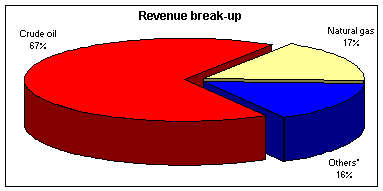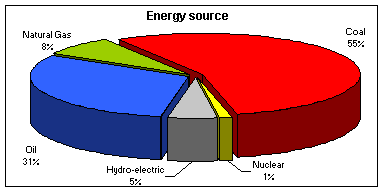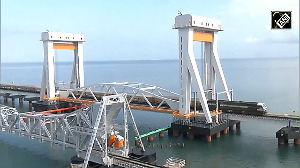| Issue Summary |
|
| ||||||||||||||||||||||||||||
| Issue structure |
|
| Employees | Existing Shareholders | QIBs | Non-Institutional Investors | Retail Portion | |
| Number of shares | Maximum of 14.3 m shares | Maximum of 14.3 m shares | Maximum of 57.04 m shares | Minimum of 28.52 m shares | Minimum of 28.52 m shares |
| % offered from Net public offer | Maximum 10% | Maximum 10% | Maximum 50% | Minimum 25% | Minimum 25% |
| Minimum Bid/Application Size | 10 equity shares | 10 equity shares | Rs 50,001 | Rs 50,001 | 10 equity shares |
| In multiples of | 10 shares | 10 shares | 10 shares | 10 shares | 10 shares |
| Maximum Bid/Application Size | Not exceeding 10% of the offer | Not exceeding 10% of the offer | Not exceeding the size of the offer | Not exceeding the size of the offer | Not exceeding Rs 50,000 |
| Background |
|
|
Oil and Natural Gas Corporation (ONGC) is an integrated oil and gas company engaged in the business of exploration, development and production of crude oil and natural gas and the production of value-added products such as LPG, naphtha and SKO (superior kerosene oil). ONGC is also the largest oil and gas company in India as measured by total proved reserves and production. It is one of the 'Navratna' PSUs with a GOI stake of 74.1% (post issue). | |
| Business | |||||||||||||||||||||||||||||||||||||||||||||
|
ONGC accounts for nearly 85% of domestic crude and natural gas supply in India. ONGC's domestic production was approximately 154.8 m barrels of oil and approximately 19.5 BCM (billion cubic meters) of natural gas in 9mFY04 (nine months ended December 2003). Sale of crude is the principle business of the company accounting for 67.6% of revenues. ONGC is engaged in exploration and production activities in eight foreign countries through its subsidiary ONGC Videsh (OVL). OVL has targeted 20 MT (million tonnes) of oil equity by the end of year 2010. The company is also engaged in the refinery business through its subsidiary MRPL, in which it holds a 71.6% stake. It is all set to enter the retail arena with a license to set up 1,100 retail outlets, thereby making it a truly integrated oil and gas company.
| |||||||||||||||||||||||||||||||||||||||||||||
| Promoters | |||||||||||||||||||||||||||||||||||||||||||||
| ONGC is a flagship integrated oil and natural gas company with a GOI holding of 74.1% (post-issue). The company was set up primarily for the purpose of oil and gas exploration and production of value-added products such as LPG, naphtha and SKO. | |||||||||||||||||||||||||||||||||||||||||||||
| Sector | |||||||||||||||||||||||||||||||||||||||||||||
|
In India, oil and natural gas production is largely dominated by two major PSUs, namely, ONGC and Oil India (OIL). ONGC accounts for approximately 84% of the domestic supply while OIL and other small and private players account for the rest. Domestic supply of crude and natural gas production
Traditionally, domestic oil industry had been regulated with regard to pricing and allocation to such an extent that the oil and gas prices along with the allocation of crude being explored domestically, was decided by the government. India imports 70% of the crude requirements from abroad. Significant industrial activity in the Indian economy over the past decade has resulted in strong increase in energy consumption, which has led to opening up of the sector in phases by the GOI. As a result, the GOI implemented the new exploration and licensing program (NELP) in order to encourage private participation through competitive bidding in exploration fields. Currently, the GOI has allowed 100% FDI (foreign direct investment) in the upstream activities through automatic route. The introduction of NELP has brought about some interest in the exploration activities with private and foreign entities such as Reliance Industries, Cairn Energy and Niko resources being granted licenses. The recent dismantling of APM (administered price mechanism) has proved to be a boon for the companies engaged in the upstream activities. These companies can now negotiate at international crude prices unlike the prices set by the Government before April 2002. However, the GOI has a major say in the allocation of crude to other oil PSUs thereby limiting the negotiating power of companies such as ONGC and OIL. Currently, with growing demand, major oil PSUs like GAIL and IOC are venturing into exploration activities and HPCL all set to explore with its subsidiary Prize Petroleum, thereby raking in the benefits of integration. With the growing demand for energy, demand for alternative fuels such as LNG, CNG and CBM (coal bed methane) is likely to rise. ONGC has been awarded CBM fields during the fourth round of NELP and plans to start commercial production in 1QFY05. Gas consumption
Although, coal and crude oil form a major part of the primary energy consumption in India, this is largely due to the fact that other sources of energy have been relatively untapped. Natural gas, as a source of primary energy accounts for a meager 8%. This could largely be attributed to supply constraints. However, Petronet LNG importing gas and Shell setting up its terminal at Hazira, along with recent gas finds by Reliance and ONGC have come as an encouraging development, which are likely to change the dynamics of energy consumption in the long run.
| |||||||||||||||||||||||||||||||||||||||||||||
| Reasons to apply |
|
|
Near monopoly and high entry barriers: ONGC currently accounts for 84% of the domestic natural gas and crude supply, which can be largely attributed to its vast geographical presence across the country. To put things into perspective, ONGC's domestic exploration licenses cover a total area of approximately 6,80,800 sq. kms and has been awarded almost 50% of the total blocks that have been granted under NELP. Further, the segment requires a large capital commitment and also a long gestation period. For instance, ONGC spends almost Rs 40 m per day on its three exploration ships in the Porbandar coast and two ships in the Krishna Godavari delta. | |
|
Benefits of downward integration: ONGC has been granted license to set up 1,100 retail outlets for the purpose of marketing petroleum products and motor spirit. Further, it has acquired management control of MRPL, which marks its entry into the refinery business. All this augurs well for ONGC, with demand for petroleum products likely to give a fillip to the revenue side and stable supply of crude to its own refinery being the advantage on the cost side. | |
|
OVL's encouraging business model: ONGC through its wholly owned subsidiary, ONGC Videsh (OVL), has picked up stake in oil equities abroad (eight countries) and has a target to expand its oil equity base to 20 MT by 2010. This shall to an extent reduce India's dependence on crude imports. Also, OVL plans to further venture in African and Latin American countries for the purpose of exploration of oil and gas. It should be noted that this move by ONGC is of utmost importance given that its domestic oil fields have been in the mature stage of production and the company planning to redevelop these fields and upgrade technologies. With OVL, the company has diversified its exploration and production business rather than depending on domestic produce. | |
|
Firm crude prices likely to continue: Pre-FY02, ONGC had to sell its produce at regulated prices thereby capping the upward potential due to rise in international crude prices. However, with the dismantling of APM, ONGC now realizes international prices for crude. Off late, crude prices have remained firm at above US$ 31 levels, which has benefited ONGC. We expect the crude prices to remain firm for the time being and stabilize at around US$ 29 levels in the foreseeable future. This shall be beneficial to ONGC over the medium term. Also, on the retail side, ONGC has better economies to take on competition. | |
|
Deregulation of gas prices: Currently, a natural gas price is determined by the MOPNG (ministry of petroleum and natural gas) and is sold within a range of Rs 2,150/TSCM (thousand standard cubic meters) to Rs 2,850/TSCM. However, with the GOI showing signs of deregulating this segment, it is a positive for ONGC, as it is the largest producer of natural gas accounting for nearly 85% of domestic supply. | |
|
Abolishment of subsidies: Over the past few years, the government has been reducing its share in the LPG and SKO (superior kerosene oil) subsidy bill and it is likely that in the next 2 to 3 years, the GOI's share will become zero. As of now, ONGC is one of the companies, which is contributing to the subsidy bill. Going forward, we feel the oil companies shall not bear the burden and are likely to pass it on to the end users. This shall not only reduce ONGC's current outflow by way of subsidies, but shall also give the company a reasonable return on the products as per market determined rates and a further advantage over its competitors since it is diversifying into the downstream segment as well. Government: Hands-off...
| ||||||||||||||||
|
MRPL's effect on the balance sheet: It made business sense for ONGC to acquire MRPL, as it did not have its own refining base. Also, to set up a refinery of MRPL's capacity, it would have cost 4 times more than what ONGC actually paid (Rs 10.6 bn) to acquire management control. Further, MRPL's accumulated losses shall come in as a handy tax-shield on a consolidated basis. |
| Reasons not to apply |
|
|
Government control on allocation: Post APM, ONGC has been independent to sell its product at international crude prices to its customer refineries. However, the GOI continues to allocate most of the crude oil produced in the industry to other PSU refineries. As a result, ONGC, as per MOU, has limited power to sell its produce independently in the open market at international prices. | |
|
Government deregulation: The GOI recently allowed 100% FDI through the automatic route in the petroleum sector. Also, foreign and private players have now been allowed to set up retail outlets, thereby marking their entry into the downstream segment. With the growing auto sector and also the increasing acceptability of LPG as a cooking medium, we expect competition in the downstream segment to increase in the long term. Also, ONGC shall have to compete against established marketing players such as IOC, BPCL, HPCL and IBP, together sharing a retail base of 20,000 outlets. | |
|
LPG and kerosene subsidies: GAIL and ONGC have been roped in to share the subsidy on LPG and Kerosene and this shall have an adverse impact on the financials. Further, the share of the Government's contribution in the subsidy is decreasing, thereby adding onto the already heavy burden on these companies. Also, ONGC, being a GOI controlled company, is not in a position to increase LPG prices due to political considerations (elections round the corner). | |
|
High capital expenditure plans: This business requires a large capex along with a high gestation period. ONGC plans to make substantial investments in its quest to acquire more oil equity abroad and to redevelop its maturing fields and improve recovery of crude oil reserves. This shall result in additional capex to the tune of US$ 2.1 bn by 2007. To put things in perspective, ONGC's Mumbai offshore basin is the largest crude oil and natural gas producing basin. The production has been very volatile - peaking in 1990 and the recording a low in 1993 and a recovery path in the mid '90s. However, off late production has once again been on a declining stage. Consequently, ONGC has planned expenditure to the tune of around US$ 1.8 bn to redevelop this ageing field. | |
|
OVL's venture into politically unstable areas: OVL has its presence in 8 international regions, namely, Iraq, Iran, Sudan, Vietnam, Myanmar, Syria, Libya and Russia. Most of these regions have witnessed instability in the recent past due to geo-political reasons or otherwise. It should be noted that governments worldwide have influenced the oil and gas industry and any such untoward incident shall impact OVL's business causing delay in operations or even resulting in cancellation of contracts due to reasons such as environmental controls, hostilities, etc. | |
|
High contingent liabilities: ONGC has a high component of contingent liabilities amounting to Rs 183 bn and is also a defendant in many legal proceedings. The company is facing claims to the tune of Rs 7.2 bn from excise, customs and income tax authorities among others. In case these claims do materialize, the company shall witness a dent in its financials. | |
| Financial Performance |
|
| (Rs m) | FY01 | FY02 | FY03 | 9mFY04 | |
| Net sales | 236,403 | 232,338 | 347,385 | 240,532 | |
| Other income | 15,310 | 6,335 | 19,460 | 10,458 | |
| Expenditure | 110,383 | 109,274 | 163,274 | 106,556 | |
| Operating profit (EBDITA) | 126,020 | 123,064 | 184,111 | 133,977 | |
| Operating profit margin (%) | 53.3% | 53.0% | 53.0% | 55.7% | |
| Interest | 5,234 | 2,847 | 1,466 | 216 | |
| Recouped costs | 44,533 | 38,054 | 41,273 | 39,055 | |
| Profit before tax | 91,563 | 88,497 | 160,832 | 105,165 | |
| Adjustments | 6 | 55 | 407 | 358 | |
| Adjusted PBT | 91,569 | 88,552 | 161,239 | 105,522 | |
| Tax | 39,281 | 36,574 | 55,945 | 38,816 | |
| Profit after tax/(loss) | 52,289 | 51,979 | 105,293 | 66,707 | |
| Adjustments | 1,534 | (6,288) | 4,680 | (1,067) | |
| Adjusted PAT | 53,823 | 45,691 | 109,973 | 65,639 | |
| Net profit margin (%) | 22.1% | 22.4% | 30.3% | 27.7% | |
| No. of shares (m) | 1,426.0 | 1,426.0 | 1,426.0 | 1,426.0 | |
| Diluted earnings per share (Rs)* | 37.7 | 32.0 | 77.1 | 61.4 | |
# Adjustments relating to prior period items and restatements/font>
| Shareholding |
|
| (%) | Pre-Offer | Post-Offer |
| GOI | 84.11 | 74.11 |
| IOC | 9.61 | 9.61 |
| GAIL | 2.4 | 2.4 |
| Public | 3.88 | 13.88 |
| Comparative Valuations and comments |
|
| 9mFY04 | ONGC | IOC | HPCL | BPCL |
| Current price (Rs) | 764 | 473 | 466 | 480 |
| Price to earnings (x) | 9.9 | 8.4 | 10.3 | 11.5 |
| Price to book value (x) | 3.0 | 2.9 | 2.34 | 3.03 |
| Operating margin (%) | 53.0 | 9.4 | 5.9 | 5.5 |
| Net profit margin (%) | 30.3 | 6.1 | 3.2 | 2.9 |
| The above valuations give an overview of the super normal margins enjoyed by ONGC vis-à-vis IOC, HPCL and BPCL. Although not equally comparable to ONGC, the comparison holds water given the fact that it is now venturing into the retail segment of the business, which has by far, been the forte of these oil marketing PSUs.
Going forward, we believe ONGC shall benefit from integration and expansion. Also, with almost 50 per cent of the fields granted to ONGC under NELP, there is enough potential for the company to grow in the business straddle. Perhaps the apprehensions are susceptibility to volatile crude prices, government intervention and large-scale capital expenditure plans for the next five years. Overall, positives seem to outweigh negative from a long-term perspective. |









 © 2025
© 2025